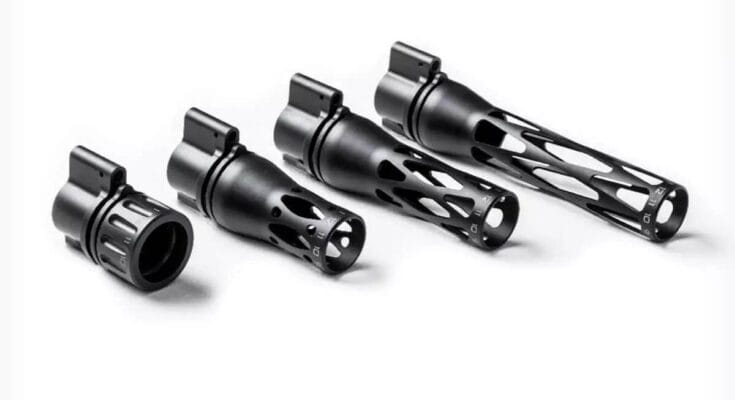A gas block is a component of an AR-15 that regulates gas flow from the barrel to the gas tube. It ensures the rifle cycles properly.
The gas block plays a crucial role in the AR-15’s gas system. Located on the barrel, it captures gas from each fired round. This gas travels through the gas tube to the bolt carrier group. As a result, the bolt cycles, ejecting the spent casing and chambering a new round.
Proper functioning of the gas block ensures reliable performance. Different types of gas blocks, such as adjustable and fixed, offer various customization options. Understanding the gas block’s role helps in maintaining and optimizing an AR-15 for specific needs.
Introduction To Gas Blocks
The AR-15 is a popular rifle. One crucial part is the gas block. Understanding it can improve your shooting experience.
Basic Concept
A gas block is a small component. It sits on the barrel of the AR-15. The gas block captures gas from the fired bullet. This gas cycles the action. It makes the gun ready for the next shot.
| Component | Function |
|---|---|
| Gas Block | Captures gas to cycle the action |
| Barrel | Holds the gas block |
Importance In Ar-15
The gas block’s role is vital. It ensures reliable cycling of the gun. Without it, the AR-15 won’t function correctly. Different types of gas blocks exist. Adjustable gas blocks let you control gas flow. This can improve performance.
A good gas block can enhance shooting accuracy. It reduces recoil and wear. The gas block i

Credit: www.reddit.com
Types Of Gas Blocks
The AR-15 is a popular rifle due to its versatility. One key component is the gas block. The gas block ensures proper cycling of the firearm. There are different types of gas blocks. This section will explain the main types.
Fixed Gas Blocks
A fixed gas block has a set gas flow. It is simple and reliable. Fixed gas blocks are often used by beginners. They require little maintenance. Fixed gas blocks are usually made from durable materials. They fit securely on the barrel.
| Features | Benefits |
|---|---|
| Set gas flow | Consistent performance |
| Durable materials | Long-lasting |
| Easy installation | Beginner-friendly |
Adjustable Gas Blocks
An adjustable gas block allows you to control gas flow. It is useful for fine-tuning your rifle. Adjustable gas blocks are preferred by advanced users. They help in reducing recoil and improving accuracy. These gas blocks offer more customization. They are ideal for different ammunition types.
- Control gas flow
- Reduce recoil
- Improve accuracy
- Customization options
- Better for various ammo types
Understanding the types of gas blocks helps in choosing the right one. Both fixed and adjustable gas blocks have their own benefits. Make an informed choice for your AR-15.
Materials And Construction
An AR-15 gas block is a crucial component that regulates gas flow in the rifle. Let’s delve into the materials used and durability considerations.
Common Materials
Gas blocks are commonly made from steel, aluminum, or titanium.
- Steel: Offers robustness and heat resistance.
- Aluminum: Lightweight and corrosion-resistant.
- Titanium: Provides strength without adding much weight.
Durability Considerations
When choosing a gas block, consider:
- Corrosion resistance for longevity.
- Heat resistance to withstand high temperatures.
- Sturdiness to ensure reliable performance.

Credit: blog.mountsplus.com
Installation And Adjustment
Understanding the installation and adjustment of a gas block is vital for AR-15 enthusiasts. Proper installation ensures the rifle functions smoothly and reliably. Adjusting the gas block optimizes performance, enhancing the shooting experience.
Step-by-step Guide
Follow this simple guide to install and adjust your gas block:
- Gather Tools: Ensure you have an AR-15 armorer’s wrench, Allen wrenches, and a torque wrench.
- Prepare the Rifle: Ensure the rifle is unloaded and on a stable surface.
- Remove Handguard: Carefully detach the handguard to access the gas block area.
- Align the Gas Block: Position the gas block over the gas port on the barrel.
- Secure the Gas Block: Tighten the screws or pins using the Allen wrench.
- Adjust the Gas Block: Use the adjustment screw
Compatibility With Ar-15 Models
Understanding the compatibility of gas blocks with AR-15 models is crucial. Each AR-15 may have different requirements based on design and specifications. Selecting the right gas block ensures optimal performance and reliability.
Matching Gas Blocks To Barrels
Matching gas blocks to barrels involves key considerations. Different barrels have different diameters and gas port locations. Ensuring the gas block fits the barrel diameter is essential.
The most common barrel diameters for AR-15s are:
- 0.625 inches (Pencil Barrels)
- 0.750 inches (Government and Medium Profile Barrels)
- 0.936 inches (Bull Barrels)
Check the gas port location on your barrel. It must align with the gas block port. This alignment ensures proper gas flow and reliable cycling.
| Barrel Diameter | Common Use |
|---|---|
| 0.625 inches | Pencil Barrels |
| 0.750 inches | Government and Medium Profile Barrels |
| 0.936 inches | Bull Barrels |
Aftermarket Options
There are many aftermarket gas block options available. These can be adjustable or fixed. Adjustable gas blocks allow you to fine-tune the gas flow. This is beneficial for customizing rifle performance.
Some popular aftermarket brands include:
- Superlative Arms
- Seekins Precision
- Odin Works
When choosing an aftermarket gas block, consider the material and coating. Stainless steel and nitride coatings offer durability and corrosion resistance.
Check for compatibility with your AR-15 model before purchasing. This ensures a perfect fit and optimal performance.
Performance Enhancements
When it comes to enhancing the performance of an AR-15, the gas block plays a crucial role. Let’s delve into how it improves recoil management and precision shooting.
Recoil Management
A gas block aids in reducing recoil for better stability.
Precision Shooting
For precision shooting, the gas block ensures consistent gas flow.
Maintenance And Troubleshooting
A gas block in an AR-15 directs gas from fired rounds to cycle the action. It plays a crucial role in firearm reliability. Proper maintenance and troubleshooting ensure optimal performance.
Routine Cleaning
Regularly clean the gas block to prevent malfunctions.
Use a soft cloth to wipe off dirt and residue.
Inspect for any signs of carbon buildup.
Identifying Issues
Check for gas leaks or blockages.
Ensure proper alignment with the gas tube.
Look for any signs of wear or damage.
Legal And Safety Considerations
Understanding the legal and safety considerations of a gas block is crucial. This ensures both compliance with laws and the safe handling of your AR-15.
Regulatory Compliance
Regulatory compliance is key for any AR-15 owner. Different regions have different laws on firearms. Ensure your gas block is legal in your area.
Check the Bureau of Alcohol, Tobacco, Firearms, and Explosives (ATF) regulations. Local laws can also vary, so consult local authorities.
| Region | Regulation |
|---|---|
| United States | ATF guidelines |
| California | State-specific laws |
| New York | State-specific laws |
Keep all necessary documentation. This includes purchase receipts and any permits. These documents prove the legality of your gas block.
Safe Handling Practices
Safe handling practices are essential. Always ensure your AR-15 is unloaded before inspection or maintenance.
- Wear protective gear: Safety glasses and ear protection are must-haves.
- Use proper tools: Use the correct tools for installation and adjustments.
- Regular maintenance: Clean and inspect the gas block regularly.
Follow the manufacturer’s instructions. These instructions are specific to your gas block model.
- Check for any wear or damage.
- Ensure the gas block is securely attached.
- Test the firearm in a controlled environment.
Improper handling can lead to accidents. Always prioritize safety to prevent injuries.
Conclusion And Final Thoughts
Understanding the role of a gas block in an AR-15 is essential. This component ensures your rifle functions correctly. It manages the gas flow from the fired cartridge. This allows for smooth cycling and reloading. In this section, we will summarize key points and explore future trends in gas blocks.
Summary Of Key Points
- A gas block directs gas from the barrel to the gas tube.
- This gas helps cycle the action of the AR-15.
- Different types of gas blocks include adjustable and fixed models.
- Adjustable gas blocks allow fine-tuning of gas flow.
- Proper gas block selection enhances rifle performance.
Future Trends In Gas Blocks
The future of gas blocks is promising. Adjustable gas blocks will see more innovation. Users want more control over their rifles. New materials will make gas blocks lighter and stronger. Titanium and carbon fiber are popular choices. Smart gas blocks with digital controls may emerge. These could offer real-time adjustments via a smartphone app.
Modularity will also be a key trend. Interchangeable parts will provide flexibility. This allows users to adapt their rifles for different needs. Expect to see more user-friendly designs. Installation will become easier, even for beginners.
The focus on precision and efficiency will drive future developments. More efficient gas blocks mean less wear and tear. This extends the lifespan of your AR-15. Investing in a good gas block is a wise choice for any AR-15 owner.

Credit: www.reddit.com
Frequently Asked Questions
What Is A Gas Block On An Ar-15?
A gas block regulates the gas flow from the barrel to the gas tube. It ensures the AR-15 cycles correctly by redirecting gas.
How Does A Gas Block Work?
A gas block redirects gas from the barrel to the gas tube. This action cycles the bolt carrier group and chambers the next round.
Why Is A Gas Block Important?
A gas block ensures reliable cycling of the AR-15. It plays a crucial role in the firearm’s operation and performance.
Can You Adjust An Ar-15 Gas Block?
Yes, some gas blocks are adjustable. This allows you to fine-tune gas flow for different ammunition and shooting conditions.
Conclusion
Understanding the gas block’s function is crucial for optimizing your AR-15. It controls gas flow, ensuring reliable cycling. Choose a quality gas block to enhance performance. Proper installation and maintenance will extend your rifle’s lifespan. With the right gas block, your AR-15 will perform consistently and effectively in any situation.
Related Post:



